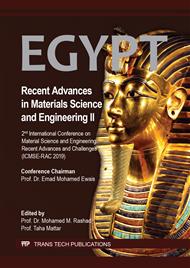[1]
H. Hu, G. Xu, M. Zhou, Q. Yuan, Effect of Mo Content on Microstructure and Property of Low-Carbon Bainitic Steels, Metals. 6 (2016) 173.
DOI: 10.3390/met6080173
Google Scholar
[2]
K. Zhu, C. Oberbillig, C. Musik, D. Loison, T. Iung, Effect of B and B+Nb on the bainitic transformation in low carbon steels, Materials Science and Engineering: A. 528 (2011) 4222–4231.
DOI: 10.1016/j.msea.2011.02.022
Google Scholar
[3]
Y.T. Zhao, C.J. Shang, S.W. Yang, X.M. Wang, X.L. He, The metastable austenite transformation in Mo–Nb–Cu–B low carbon steel, Materials Science and Engineering: A. 433 (2006) 169–174.
DOI: 10.1016/j.msea.2006.06.048
Google Scholar
[4]
F. García Caballero, C. Capdevila, J. Chao, J. Cornide, C. García Mateo, H. Roelofs, S. Hasler, G. Mastrogiacomo, The microstructure of continuously cooled tough bainitic steel, in: 2010. https://digital.csic.es/handle/10261/85371 (accessed November 14, 2018).
DOI: 10.1179/1743284710y.0000000047
Google Scholar
[5]
G. Krauss, S.W. Thompson, Ferritic Microstructures in Continuously Cooled Low- and Ultralow-carbon Steels., ISIJ International. 35 (1995) 937–945.
DOI: 10.2355/isijinternational.35.937
Google Scholar
[6]
H. Lan, L. Du, N. Zhou, X. Liu, Effect of Austempering Route on Microstructural Characterization of Nanobainitic Steel, Acta Metallurgica Sinica (English Letters). 27 (2014) 19–26.
DOI: 10.1007/s40195-013-0006-2
Google Scholar
[7]
X.L. Yang, Y.B. Xu, X.D. Tan, Y.M. Yu, D. Wu, Microstructures and Mechanical Properties of High Strength Low Carbon Bainitic Steel, MSF. 817 (2015) 257–262.
DOI: 10.4028/www.scientific.net/msf.817.257
Google Scholar
[8]
F.G. Caballero, H.K.D.H. Bhadeshia, K.J.A. Mawella, D.G. Jones, P. Brown, Design of novel high strength bainitic steels: Part 1, Materials Science and Technology. 17 (2001) 512–516.
DOI: 10.1179/026708301101510348
Google Scholar
[9]
F.G. Caballero, H.K.D.H. Bhadeshia, K.J.A. Mawella, D.G. Jones, P. Brown, Design of novel high strength bainitic steels: Part 2, Materials Science and Technology. 17 (2001) 517–522.
DOI: 10.1179/026708301101510357
Google Scholar
[10]
F.G. Caballero, H.K.D.H. Bhadeshia, Very strong bainite, Current Opinion in Solid State and Materials Science. 8 (2004) 251–257.
DOI: 10.1016/j.cossms.2004.09.005
Google Scholar
[11]
F.G. Caballero, M.J. Santofimia, C. García-Mateo, J. Chao, C.G. de Andrés, Theoretical design and advanced microstructure in super high strength steels, Materials & Design. 30 (2009) 2077–2083.
DOI: 10.1016/j.matdes.2008.08.042
Google Scholar
[12]
H.S. Hasan, M.J. Peet, M.-N. Avettand-Fènoël, H.K.D.H. Bhadeshia, Effect of tempering upon the tensile properties of a nanostructured bainitic steel, Materials Science and Engineering: A. 615 (2014) 340–347.
DOI: 10.1016/j.msea.2014.07.097
Google Scholar
[13]
Z. Yao, G. Xu, H. Hu, Q. Yuan, J. Tian, M. Zhou, Effect of Ni and Cr Addition on Transformation and Properties of Low-Carbon Bainitic Steels, Trans Indian Inst Met. 72 (2019) 1167–1174.
DOI: 10.1007/s12666-019-01590-7
Google Scholar
[14]
M. Zhou, G. Xu, J. Tian, H. Hu, Q. Yuan, Bainitic Transformation and Properties of Low Carbon Carbide-Free Bainitic Steels with Cr Addition, Metals. 7 (2017) 263.
DOI: 10.3390/met7070263
Google Scholar
[15]
J. Tian, G. Xu, M. Zhou, H. Hu, X. Wan, The Effects of Cr and Al Addition on Transformation and Properties in Low‐Carbon Bainitic Steels, Metals. 7 (2017) 40.
DOI: 10.3390/met7020040
Google Scholar
[16]
L. Bracke, W. Xu, Effect of the Cr Content and Coiling Temperature on the Properties of Hot Rolled High Strength Lower Bainitic Steel, ISIJ International. 55 (2015) 2206–2211.
DOI: 10.2355/isijinternational.isijint-2015-086
Google Scholar
[17]
P. Suikkanen, Development and processing of low carbon bainitic steels, Doctoral Thesis, University of Oulu, 2009. http://jultika.oulu.fi/files/isbn9789514292576.pdf.
Google Scholar
[18]
L. Kong, Y. Liu, J. Liu, Y. Song, S. Li, R. Zhang, T. Li, Y. Liang, The influence of chromium on the pearlite-austenite transformation kinetics of the Fe–Cr–C ternary steels, Journal of Alloys and Compounds. 648 (2015) 494–499.
DOI: 10.1016/j.jallcom.2015.06.259
Google Scholar
[19]
G.-H. Zhang, J.-Y. Chae, K.-H. Kim, D.W. Suh, Effects of Mn, Si and Cr addition on the dissolution and coarsening of pearlitic cementite during intercritical austenitization in Fe-1mass%C alloy, Materials Characterization. 81 (2013) 56–67.
DOI: 10.1016/j.matchar.2013.04.007
Google Scholar
[20]
T. Siwecki, J. Eliasson, R. Lagneborg, B. Hutchinson, Vanadium Microalloyed Bainitic Hot Strip Steels, ISIJ International. 50 (2010) 760–767.
DOI: 10.2355/isijinternational.50.760
Google Scholar
[21]
M. Opiela, W. Zalecki, A. Grajcar, Influence of plastic deformation on CCT-diagrams of new-developed microalloyed steel, Journal of Achievements in Materials and Manufacturing Engineering. 51 (2012) 78–89.
Google Scholar
[22]
M.-C. Zhao, K. Yang, F.-R. Xiao, Y.-Y. Shan, Continuous cooling transformation of undeformed and deformed low carbon pipeline steels, Materials Science and Engineering: A. 355 (2003) 126–136.
DOI: 10.1016/s0921-5093(03)00074-1
Google Scholar
[23]
G.-Y. Qiao, Y.-B. Cao, B. Liao, F.-R. Xiao, Effect of hot deformation and Nb precipitation on continuous cooling transformation of a high-Nb steel, Ironmaking & Steelmaking. 44 (2017) 359–367.
DOI: 10.1080/03019233.2016.1210935
Google Scholar


